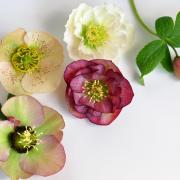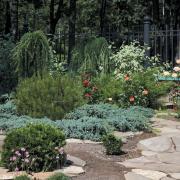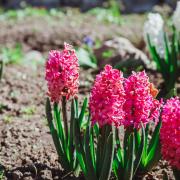There is nothing better than sitting in the garden of a summer evening, sipping on something cool and delicious with the sweet scent of roses in the air. June is a month of summer buds just bursting into bloom, and our famed English roses are no different. Roses are the world’s most popular and oldest flower, over the centuries, roses have provided inspiration for artists, poets, and storytellers alike, creating a rich history in symbolism myth. Their heady fragrance often taking centre stage for use in ancient recipes such as Turkish delight, rose tea or to create rose oils.
From patio roses, shrubs, climbing roses or in a container, the choice is endless for the garden. This can be confusing when out shopping! It’s important to decide which type of rose you want and where you want to plant it. Some people select roses for their scent, their colour or their name and rose choices can be extremely personal as well. Roses love a sunny, sheltered spot, although you will find some roses are happy with a bit of afternoon shade as well. Roses are hardy and will grow in most soil types, however they thrive in a rich, moist but well drained soil. Single flowered roses are back in vogue as they are loved by bees and other pollinators.
Planting Roses
Potted roses can be planted all year round, although you want to avoid planting when the ground is frozen or waterlogged. The first trick to planting roses is to generously water the plant just before removing it from is pot and planting. Once you have dug over the soil, you can start digging your hole, it should be about twice the width of the roots wide deep (This does depend on the size of the root ball, you want plenty of loose, rich soil around the roots. You should loosen the soil at the base of the planting hole, allowing for further root growth. Roses love organic matter in the soil, so a good, well-rotted manure is recommended. Alternatively, you can add rose compost, we recommend Westland Rose planting and potting mix, which has been specially blended to strengthen roses from the inside out, helping to build plant immunity enabling them to better withstand pests, disease, and stress.Carefully remove the rose from its pot tease out the roots of container roses, if they are congested, so they are nice and loose in the ground, allowing for faster growth. Sprinkle with mycorrhizal fungi and place the root in the centre of the hole and ensure that the point where the branches originate is at soil level and below the soil. Back fill gently and the excavated soil and organic matter mixture. Lightly firm the soil around the rose to ensure its secure. Water well.
Maintaining your roses
It’s important to deadhead your roses regularly, this promotes more flowers. Established roses do not need a lot of watering but you must water regularly during extremely hot spells. Newly planted roses need more regular watering and care. Water at the base of the plant and not over the leaves and flowers, as this can lead to mildew and some diseases. Roses are hungry plants, mulch annually with compost and use a rose feed such as Westlands Rose Food in the spring and again in mid-summer after the first flowers have bloomed. Prune roses annually, this promotes healthy growth, controls the shape of the bush, and encourages flowering, we suggest pruning in January and February each year. Roses are prone to various diseases, aphids, and fungal problems. With rose maintenance, prevention is always better than cure. To control pests and disease in your roses, there are several solutions such as encouraging wildlife and pollinators to your garden can assist in reducing aphids.

Jobs in the garden for June
• Spray roses showing signs of disease, such as black spot, powdery mildew or rust.
• Check hedges and shrubs for nesting birds before you start any trimming or pruning, so you don't disturb them.
• Support tall growing perennials such as delphiniums and large flowering dahlias with canes or plant supports.
• Cut back spring flowering perennials to encourage new foliage growth.
• Pinch out the tips of fuchsia’s to encourage bushier growth.
• Plant out tender vegetables raised indoors, including beans, tomatoes, pumpkins, courgettes and sweetcorn.
• Cover developing and ripening fruits with netting or fleece to protect them from birds.
• Spread mulch around thirsty crops such as beans and courgettes to hold in moisture around their roots.
• Apply tomato feed regularly to fruiting veg crops, including tomatoes, courgettes, pumpkins and chillies.
• Water plants daily in warm weather, ideally in the evening or early morning, and avoid splashing the foliage.
• Feed lawns with a liquid or granular lawn fertiliser.



























